Analysis of the Australian Financial Market and Risk Evaluation Report
VerifiedAdded on 2023/01/11

Paraphrase This Document

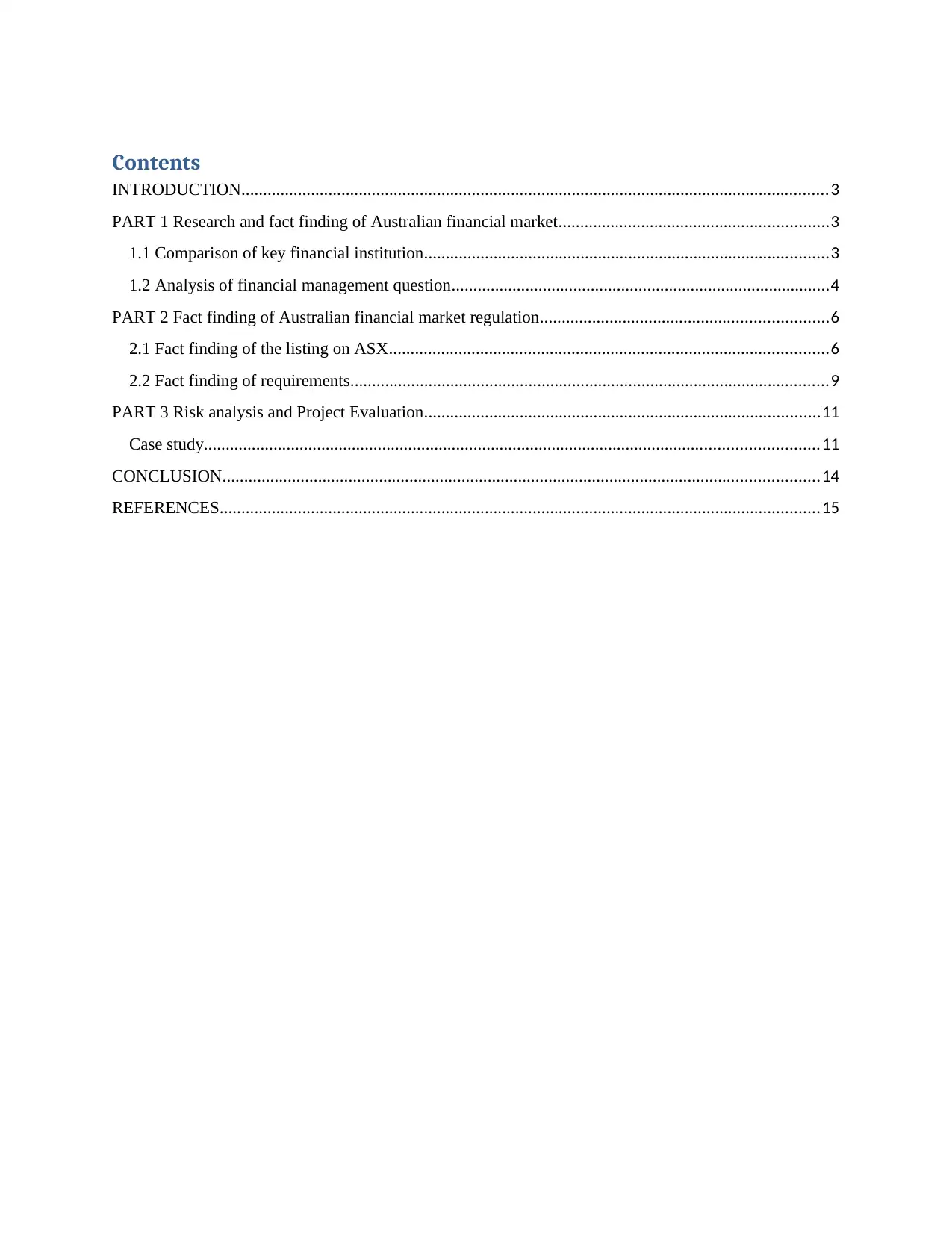
INTRODUCTION.......................................................................................................................................3
PART 1 Research and fact finding of Australian financial market..............................................................3
1.1 Comparison of key financial institution.............................................................................................3
1.2 Analysis of financial management question.......................................................................................4
PART 2 Fact finding of Australian financial market regulation..................................................................6
2.1 Fact finding of the listing on ASX.....................................................................................................6
2.2 Fact finding of requirements..............................................................................................................9
PART 3 Risk analysis and Project Evaluation...........................................................................................11
Case study.............................................................................................................................................11
CONCLUSION.........................................................................................................................................14
REFERENCES..........................................................................................................................................15
⊘ This is a preview!⊘
Do you want full access?
Subscribe today to unlock all pages.

Trusted by 1+ million students worldwide
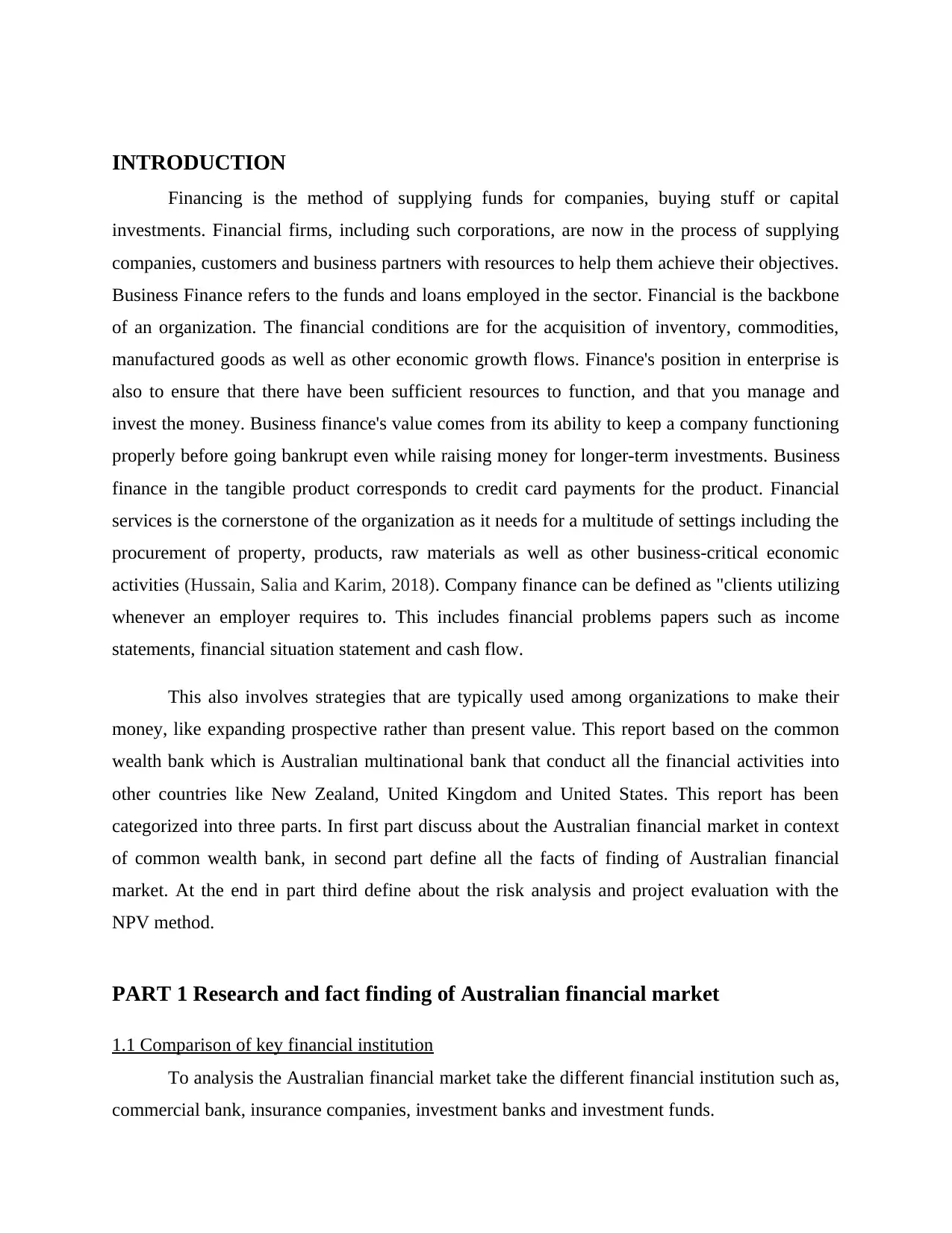
Financing is the method of supplying funds for companies, buying stuff or capital
investments. Financial firms, including such corporations, are now in the process of supplying
companies, customers and business partners with resources to help them achieve their objectives.
Business Finance refers to the funds and loans employed in the sector. Financial is the backbone
of an organization. The financial conditions are for the acquisition of inventory, commodities,
manufactured goods as well as other economic growth flows. Finance's position in enterprise is
also to ensure that there have been sufficient resources to function, and that you manage and
invest the money. Business finance's value comes from its ability to keep a company functioning
properly before going bankrupt even while raising money for longer-term investments. Business
finance in the tangible product corresponds to credit card payments for the product. Financial
services is the cornerstone of the organization as it needs for a multitude of settings including the
procurement of property, products, raw materials as well as other business-critical economic
activities (Hussain, Salia and Karim, 2018). Company finance can be defined as "clients utilizing
whenever an employer requires to. This includes financial problems papers such as income
statements, financial situation statement and cash flow.
This also involves strategies that are typically used among organizations to make their
money, like expanding prospective rather than present value. This report based on the common
wealth bank which is Australian multinational bank that conduct all the financial activities into
other countries like New Zealand, United Kingdom and United States. This report has been
categorized into three parts. In first part discuss about the Australian financial market in context
of common wealth bank, in second part define all the facts of finding of Australian financial
market. At the end in part third define about the risk analysis and project evaluation with the
NPV method.
PART 1 Research and fact finding of Australian financial market
1.1 Comparison of key financial institution
To analysis the Australian financial market take the different financial institution such as,
commercial bank, insurance companies, investment banks and investment funds.
Paraphrase This Document
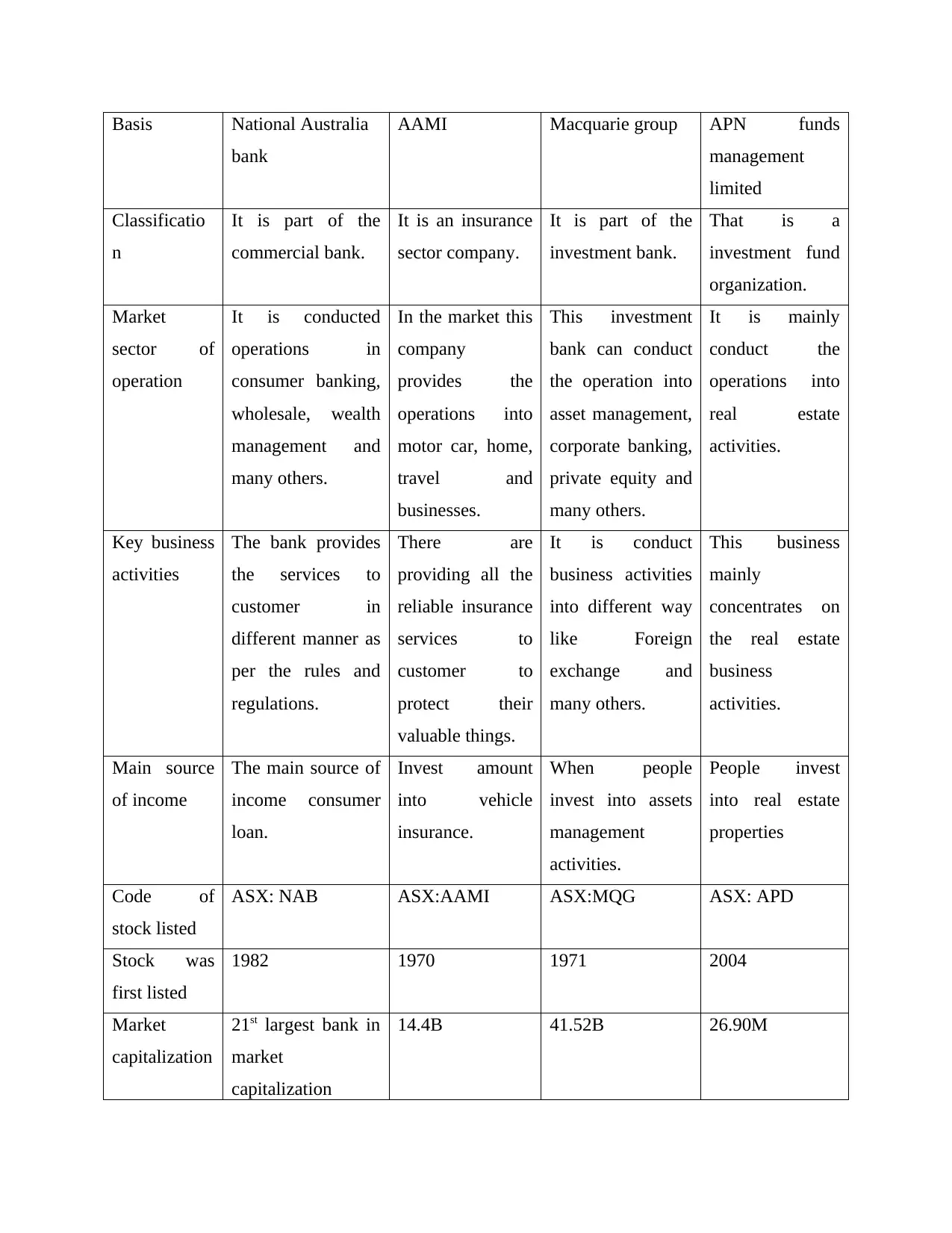
bank
AAMI Macquarie group APN funds
management
limited
Classificatio
n
It is part of the
commercial bank.
It is an insurance
sector company.
It is part of the
investment bank.
That is a
investment fund
organization.
Market
sector of
operation
It is conducted
operations in
consumer banking,
wholesale, wealth
management and
many others.
In the market this
company
provides the
operations into
motor car, home,
travel and
businesses.
This investment
bank can conduct
the operation into
asset management,
corporate banking,
private equity and
many others.
It is mainly
conduct the
operations into
real estate
activities.
Key business
activities
The bank provides
the services to
customer in
different manner as
per the rules and
regulations.
There are
providing all the
reliable insurance
services to
customer to
protect their
valuable things.
It is conduct
business activities
into different way
like Foreign
exchange and
many others.
This business
mainly
concentrates on
the real estate
business
activities.
Main source
of income
The main source of
income consumer
loan.
Invest amount
into vehicle
insurance.
When people
invest into assets
management
activities.
People invest
into real estate
properties
Code of
stock listed
ASX: NAB ASX:AAMI ASX:MQG ASX: APD
Stock was
first listed
1982 1970 1971 2004
Market
capitalization
21st largest bank in
market
capitalization
14.4B 41.52B 26.90M
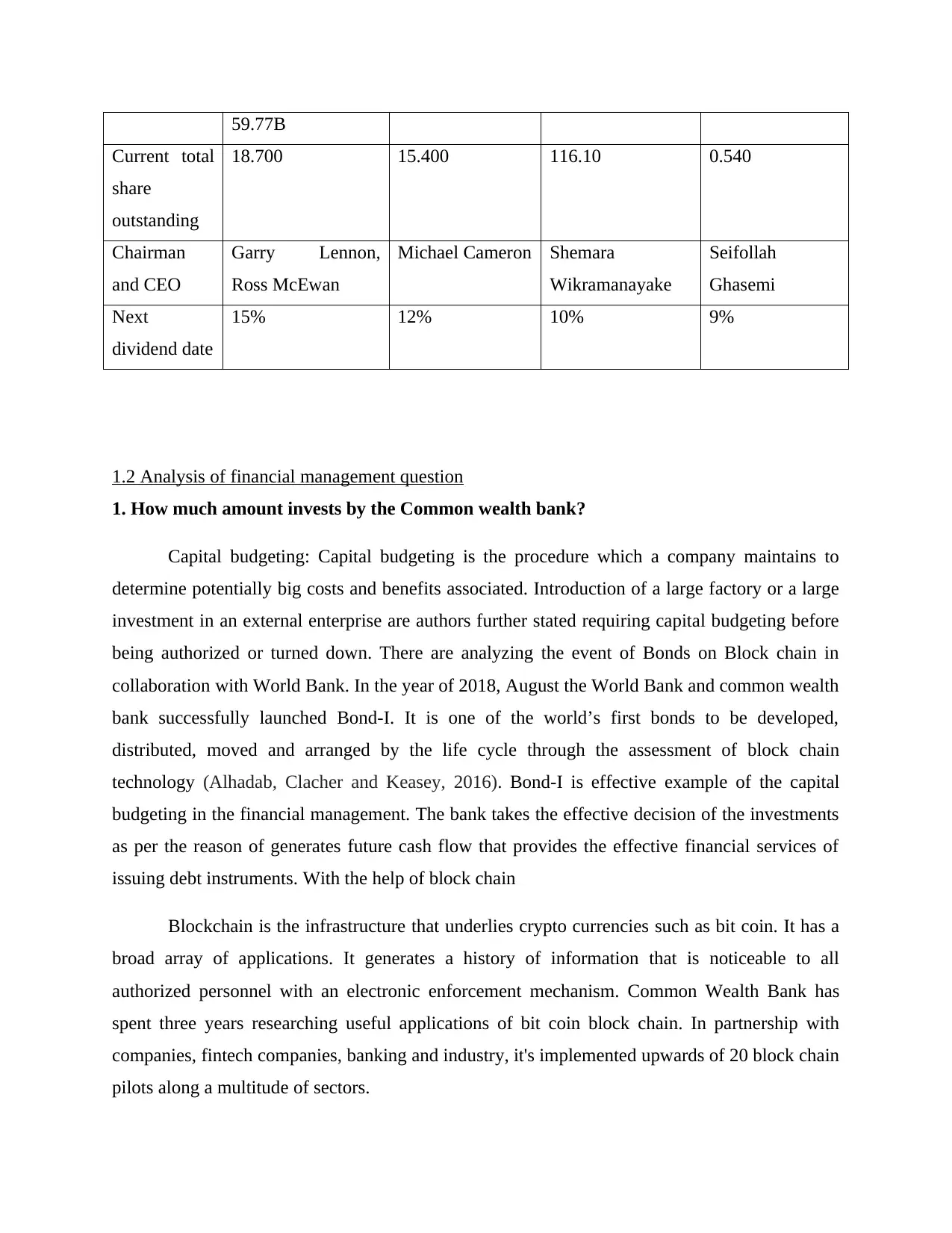
Current total
share
outstanding
18.700 15.400 116.10 0.540
Chairman
and CEO
Garry Lennon,
Ross McEwan
Michael Cameron Shemara
Wikramanayake
Seifollah
Ghasemi
Next
dividend date
15% 12% 10% 9%
1.2 Analysis of financial management question
1. How much amount invests by the Common wealth bank?
Capital budgeting: Capital budgeting is the procedure which a company maintains to
determine potentially big costs and benefits associated. Introduction of a large factory or a large
investment in an external enterprise are authors further stated requiring capital budgeting before
being authorized or turned down. There are analyzing the event of Bonds on Block chain in
collaboration with World Bank. In the year of 2018, August the World Bank and common wealth
bank successfully launched Bond-I. It is one of the world’s first bonds to be developed,
distributed, moved and arranged by the life cycle through the assessment of block chain
technology (Alhadab, Clacher and Keasey, 2016). Bond-I is effective example of the capital
budgeting in the financial management. The bank takes the effective decision of the investments
as per the reason of generates future cash flow that provides the effective financial services of
issuing debt instruments. With the help of block chain
Blockchain is the infrastructure that underlies crypto currencies such as bit coin. It has a
broad array of applications. It generates a history of information that is noticeable to all
authorized personnel with an electronic enforcement mechanism. Common Wealth Bank has
spent three years researching useful applications of bit coin block chain. In partnership with
companies, fintech companies, banking and industry, it's implemented upwards of 20 block chain
pilots along a multitude of sectors.
⊘ This is a preview!⊘
Do you want full access?
Subscribe today to unlock all pages.

Trusted by 1+ million students worldwide
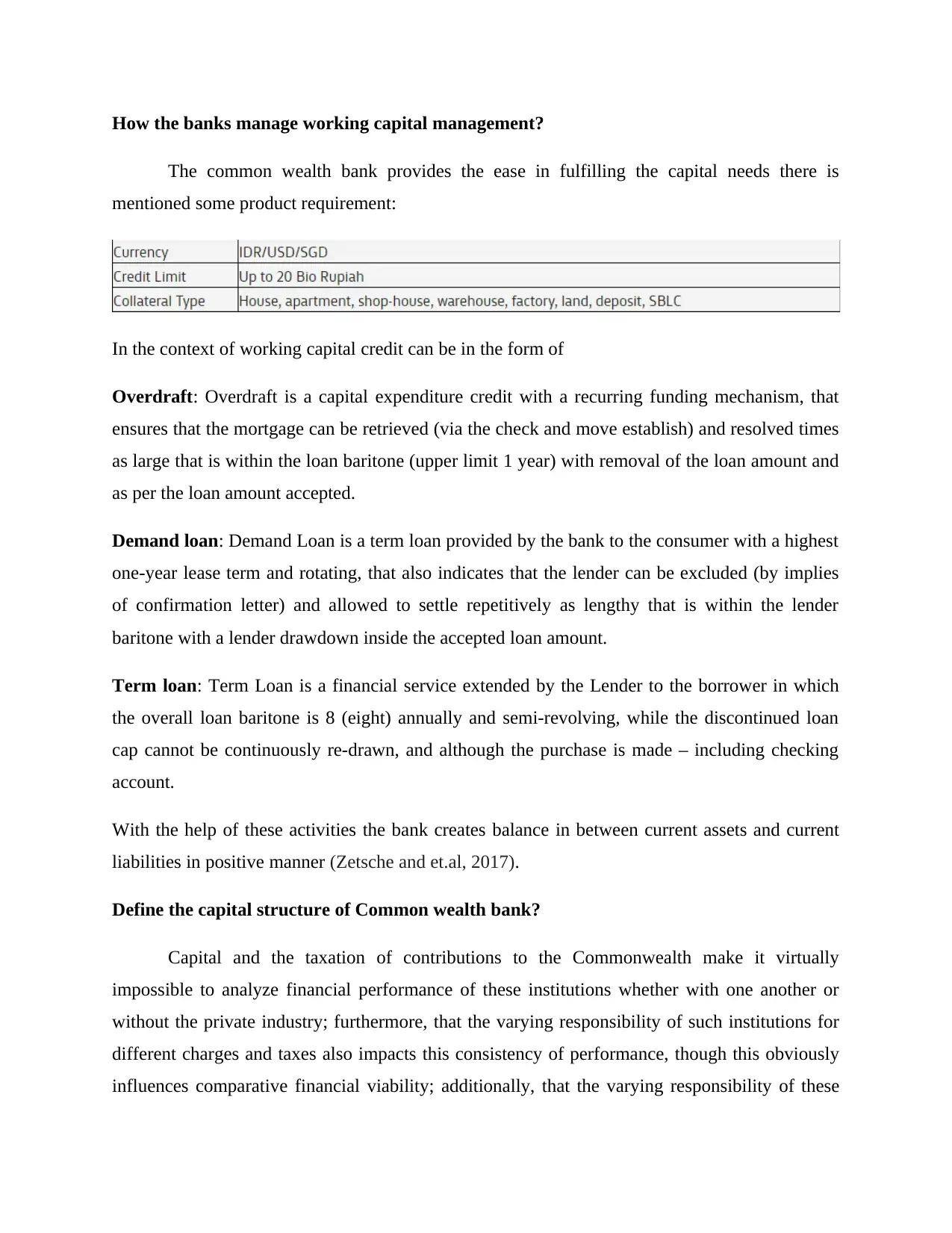
The common wealth bank provides the ease in fulfilling the capital needs there is
mentioned some product requirement:
In the context of working capital credit can be in the form of
Overdraft: Overdraft is a capital expenditure credit with a recurring funding mechanism, that
ensures that the mortgage can be retrieved (via the check and move establish) and resolved times
as large that is within the loan baritone (upper limit 1 year) with removal of the loan amount and
as per the loan amount accepted.
Demand loan: Demand Loan is a term loan provided by the bank to the consumer with a highest
one-year lease term and rotating, that also indicates that the lender can be excluded (by implies
of confirmation letter) and allowed to settle repetitively as lengthy that is within the lender
baritone with a lender drawdown inside the accepted loan amount.
Term loan: Term Loan is a financial service extended by the Lender to the borrower in which
the overall loan baritone is 8 (eight) annually and semi-revolving, while the discontinued loan
cap cannot be continuously re-drawn, and although the purchase is made – including checking
account.
With the help of these activities the bank creates balance in between current assets and current
liabilities in positive manner (Zetsche and et.al, 2017).
Define the capital structure of Common wealth bank?
Capital and the taxation of contributions to the Commonwealth make it virtually
impossible to analyze financial performance of these institutions whether with one another or
without the private industry; furthermore, that the varying responsibility of such institutions for
different charges and taxes also impacts this consistency of performance, though this obviously
influences comparative financial viability; additionally, that the varying responsibility of these
Paraphrase This Document
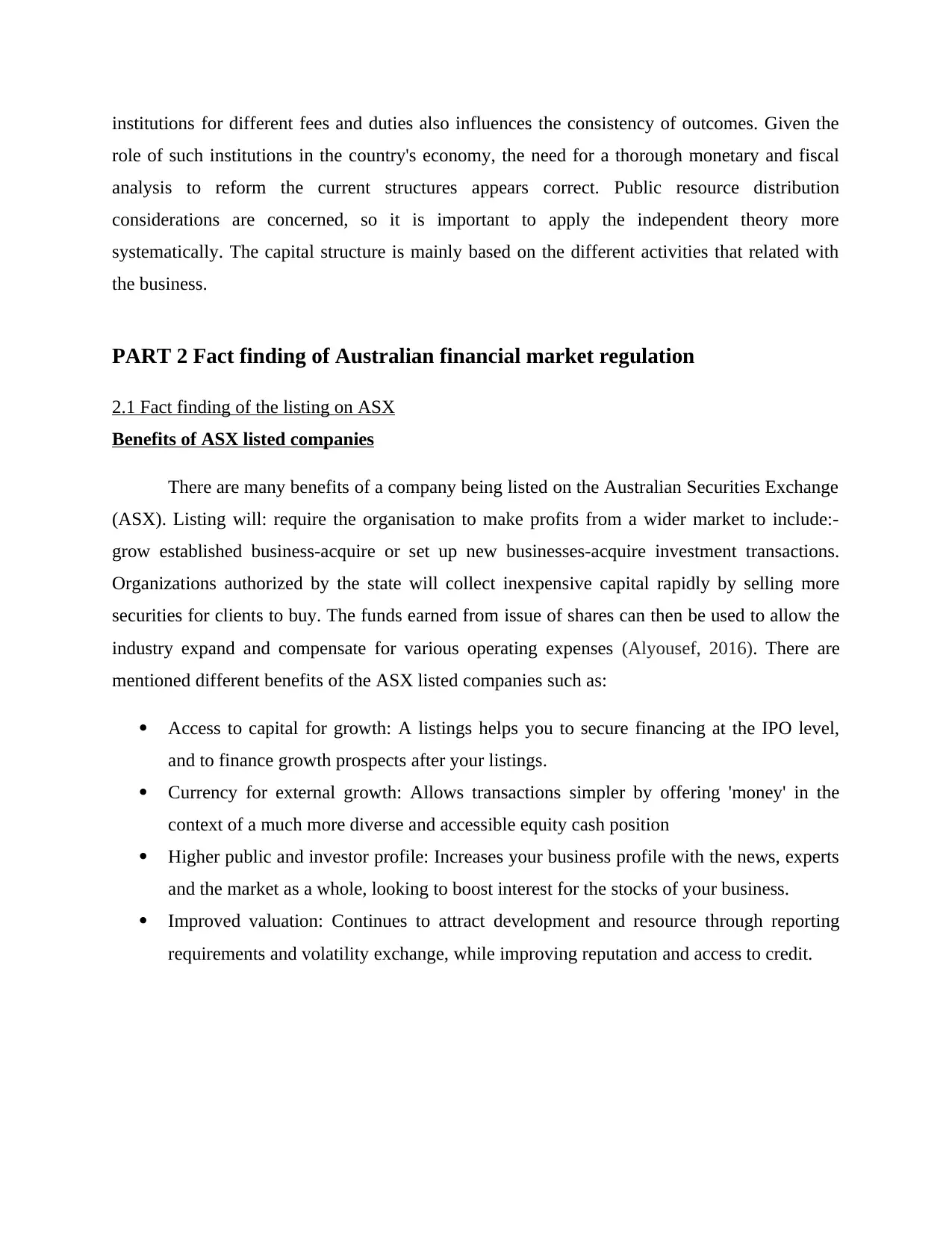
role of such institutions in the country's economy, the need for a thorough monetary and fiscal
analysis to reform the current structures appears correct. Public resource distribution
considerations are concerned, so it is important to apply the independent theory more
systematically. The capital structure is mainly based on the different activities that related with
the business.
PART 2 Fact finding of Australian financial market regulation
2.1 Fact finding of the listing on ASX
Benefits of ASX listed companies
There are many benefits of a company being listed on the Australian Securities Exchange
(ASX). Listing will: require the organisation to make profits from a wider market to include:-
grow established business-acquire or set up new businesses-acquire investment transactions.
Organizations authorized by the state will collect inexpensive capital rapidly by selling more
securities for clients to buy. The funds earned from issue of shares can then be used to allow the
industry expand and compensate for various operating expenses (Alyousef, 2016). There are
mentioned different benefits of the ASX listed companies such as:
Access to capital for growth: A listings helps you to secure financing at the IPO level,
and to finance growth prospects after your listings.
Currency for external growth: Allows transactions simpler by offering 'money' in the
context of a much more diverse and accessible equity cash position
Higher public and investor profile: Increases your business profile with the news, experts
and the market as a whole, looking to boost interest for the stocks of your business.
Improved valuation: Continues to attract development and resource through reporting
requirements and volatility exchange, while improving reputation and access to credit.
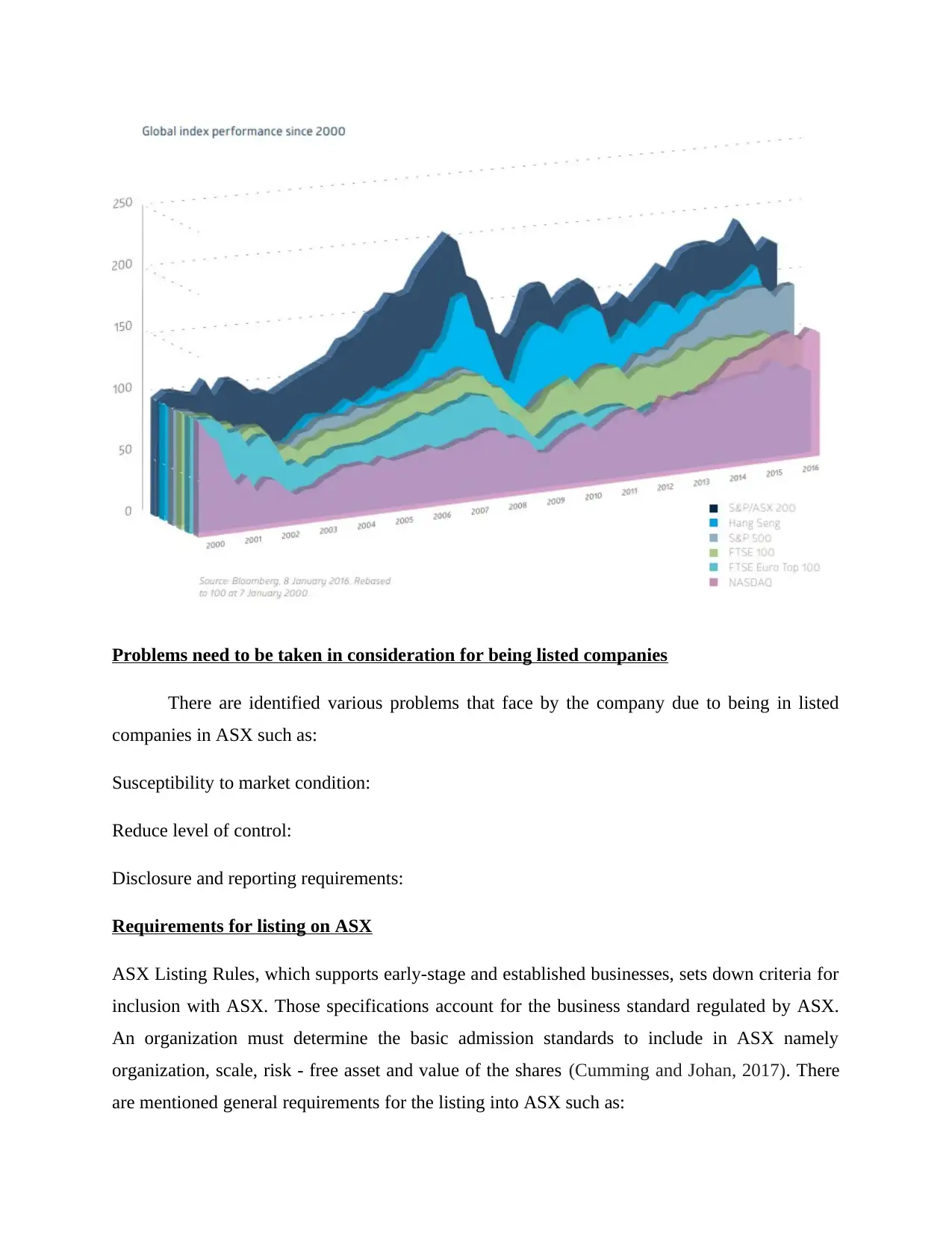
There are identified various problems that face by the company due to being in listed
companies in ASX such as:
Susceptibility to market condition:
Reduce level of control:
Disclosure and reporting requirements:
Requirements for listing on ASX
ASX Listing Rules, which supports early-stage and established businesses, sets down criteria for
inclusion with ASX. Those specifications account for the business standard regulated by ASX.
An organization must determine the basic admission standards to include in ASX namely
organization, scale, risk - free asset and value of the shares (Cumming and Johan, 2017). There
are mentioned general requirements for the listing into ASX such as:
⊘ This is a preview!⊘
Do you want full access?
Subscribe today to unlock all pages.

Trusted by 1+ million students worldwide
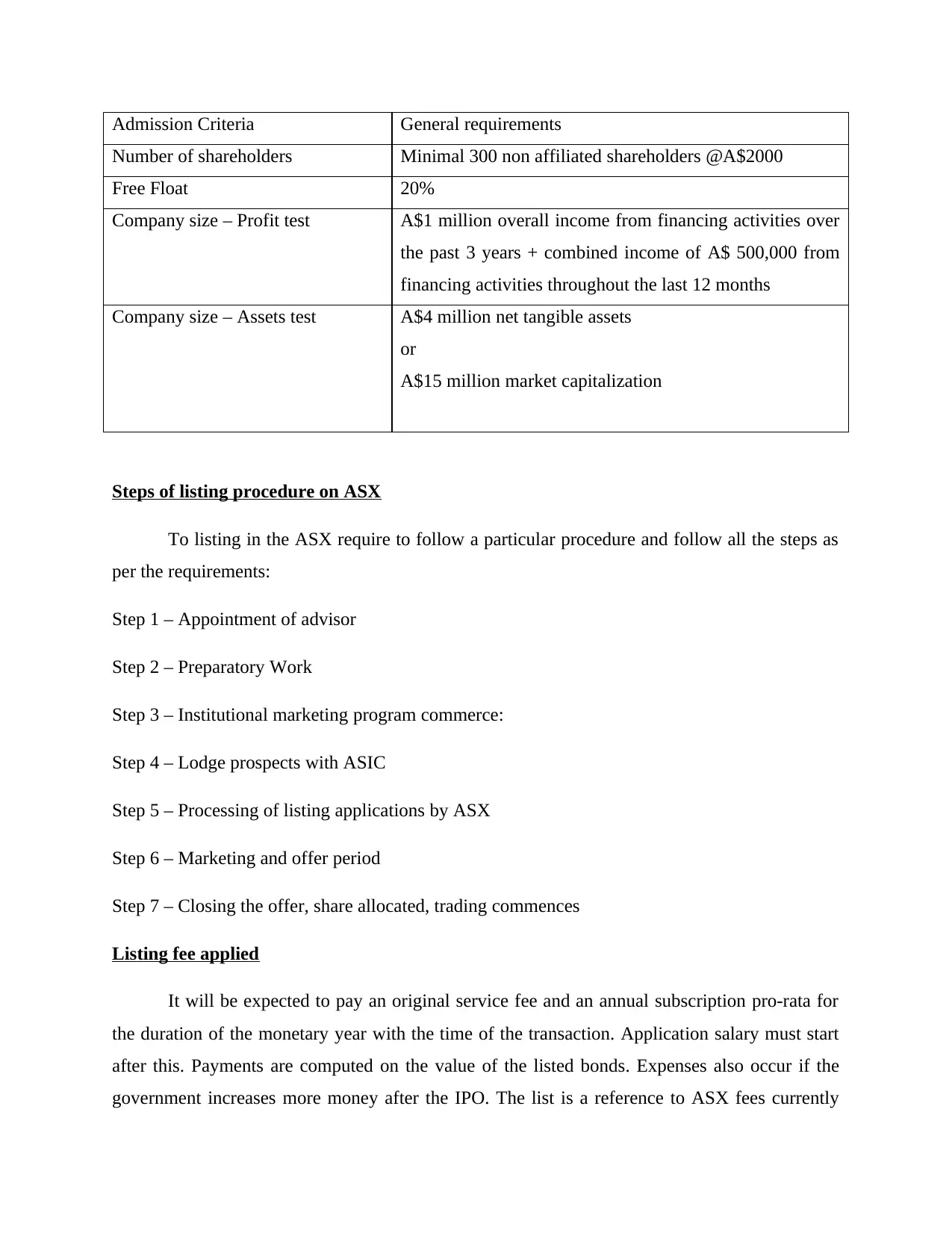
Number of shareholders Minimal 300 non affiliated shareholders @A$2000
Free Float 20%
Company size – Profit test A$1 million overall income from financing activities over
the past 3 years + combined income of A$ 500,000 from
financing activities throughout the last 12 months
Company size – Assets test A$4 million net tangible assets
or
A$15 million market capitalization
Steps of listing procedure on ASX
To listing in the ASX require to follow a particular procedure and follow all the steps as
per the requirements:
Step 1 – Appointment of advisor
Step 2 – Preparatory Work
Step 3 – Institutional marketing program commerce:
Step 4 – Lodge prospects with ASIC
Step 5 – Processing of listing applications by ASX
Step 6 – Marketing and offer period
Step 7 – Closing the offer, share allocated, trading commences
Listing fee applied
It will be expected to pay an original service fee and an annual subscription pro-rata for
the duration of the monetary year with the time of the transaction. Application salary must start
after this. Payments are computed on the value of the listed bonds. Expenses also occur if the
government increases more money after the IPO. The list is a reference to ASX fees currently
Paraphrase This Document
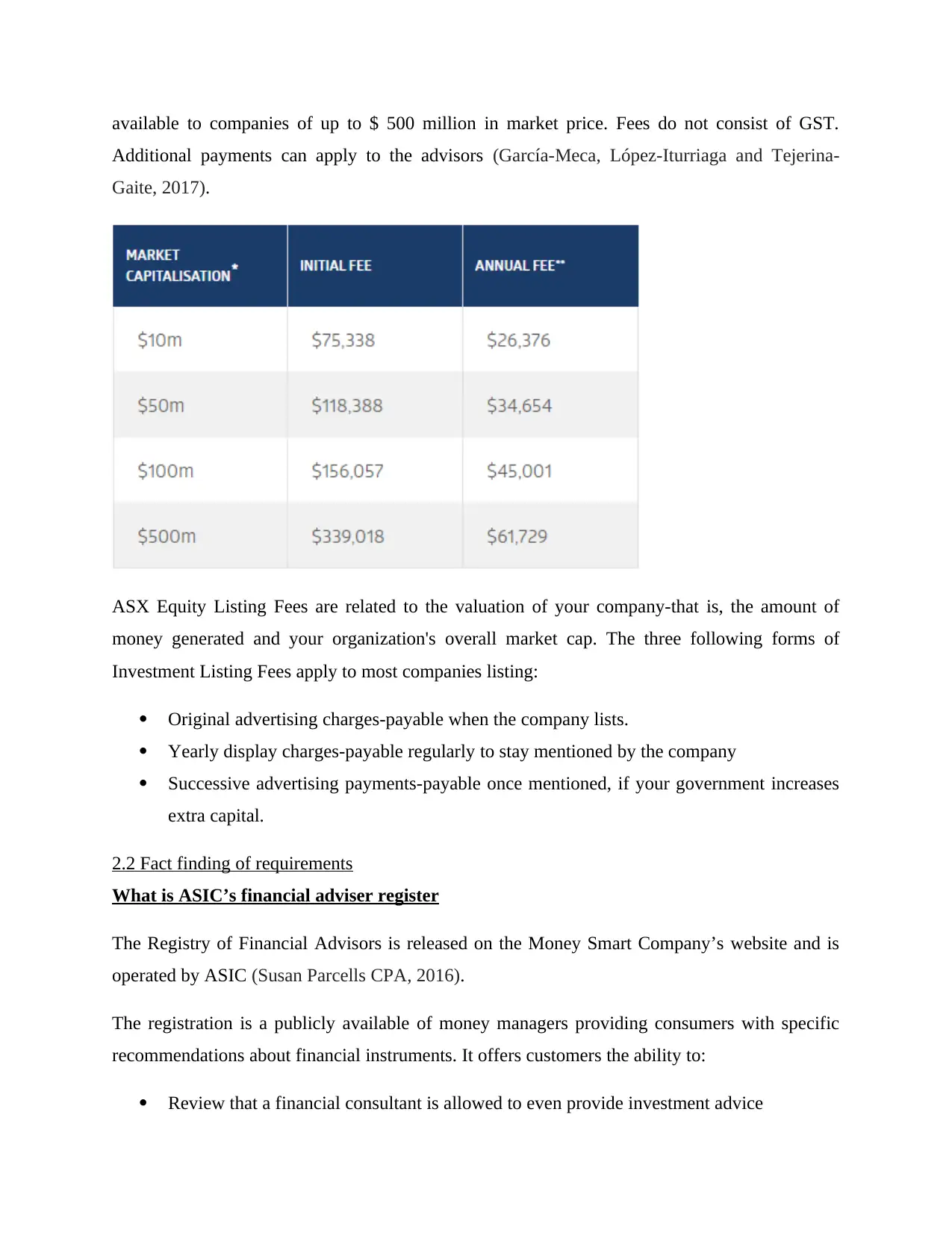
Additional payments can apply to the advisors (García-Meca, López-Iturriaga and Tejerina-
Gaite, 2017).
ASX Equity Listing Fees are related to the valuation of your company-that is, the amount of
money generated and your organization's overall market cap. The three following forms of
Investment Listing Fees apply to most companies listing:
Original advertising charges-payable when the company lists.
Yearly display charges-payable regularly to stay mentioned by the company
Successive advertising payments-payable once mentioned, if your government increases
extra capital.
2.2 Fact finding of requirements
What is ASIC’s financial adviser register
The Registry of Financial Advisors is released on the Money Smart Company’s website and is
operated by ASIC (Susan Parcells CPA, 2016).
The registration is a publicly available of money managers providing consumers with specific
recommendations about financial instruments. It offers customers the ability to:
Review that a financial consultant is allowed to even provide investment advice
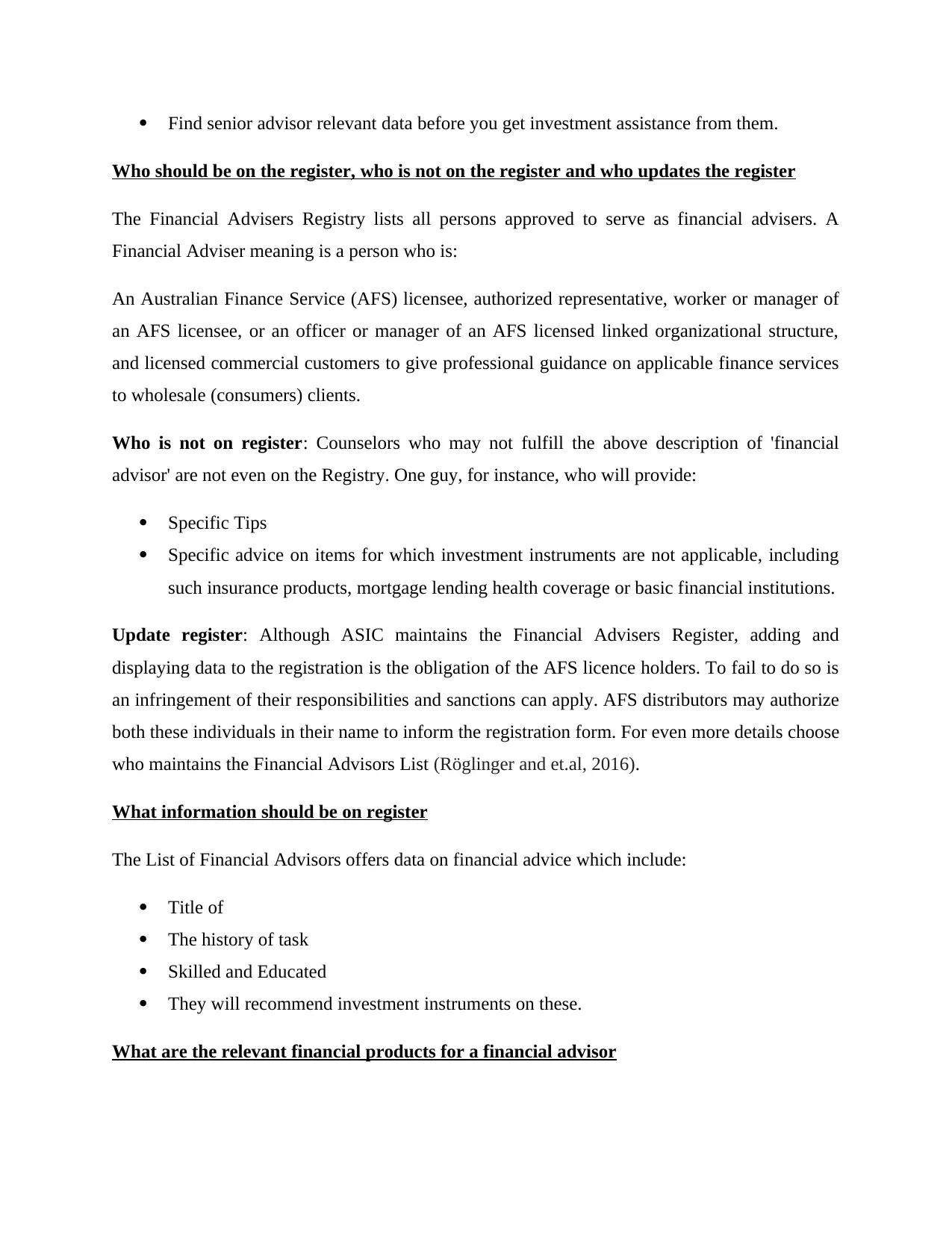
Who should be on the register, who is not on the register and who updates the register
The Financial Advisers Registry lists all persons approved to serve as financial advisers. A
Financial Adviser meaning is a person who is:
An Australian Finance Service (AFS) licensee, authorized representative, worker or manager of
an AFS licensee, or an officer or manager of an AFS licensed linked organizational structure,
and licensed commercial customers to give professional guidance on applicable finance services
to wholesale (consumers) clients.
Who is not on register: Counselors who may not fulfill the above description of 'financial
advisor' are not even on the Registry. One guy, for instance, who will provide:
Specific Tips
Specific advice on items for which investment instruments are not applicable, including
such insurance products, mortgage lending health coverage or basic financial institutions.
Update register: Although ASIC maintains the Financial Advisers Register, adding and
displaying data to the registration is the obligation of the AFS licence holders. To fail to do so is
an infringement of their responsibilities and sanctions can apply. AFS distributors may authorize
both these individuals in their name to inform the registration form. For even more details choose
who maintains the Financial Advisors List (Röglinger and et.al, 2016).
What information should be on register
The List of Financial Advisors offers data on financial advice which include:
Title of
The history of task
Skilled and Educated
They will recommend investment instruments on these.
What are the relevant financial products for a financial advisor
⊘ This is a preview!⊘
Do you want full access?
Subscribe today to unlock all pages.

Trusted by 1+ million students worldwide

explicitly, including stocks, bonds, bond funds, and health coverage. Based on the arrangement
they have had with their customers, consultants may have approval from the customers to make
judgments regarding investing in the stock market and securities. There are mentioned all the
relevant financial products such as:
Top line financial goods
Specific Goods insurance
Lending health coverage
Anyone of those product lines combined.
Professional standards applied for a financial advisor
For the financial advisor require skilled financial advisor. The professional requirements
allow financial advisors to: have a credential authorized. Take the FASEA assessment to assess
the realistic implementation of their expertise in major places of proficiency (Han, He, Pan and
Shi, 2018).
Register Financial Advisors, and
AFS Registry of license holders.
An approved employee of a financial advisor is classified on:
Activate Financial Advisors, and
A List of Approved Members.
PART 3 Risk analysis and Project Evaluation
Case study
Provided Information
Selling Price $ 22 Unit
Expected Selling Units 350000 units
Paraphrase This Document
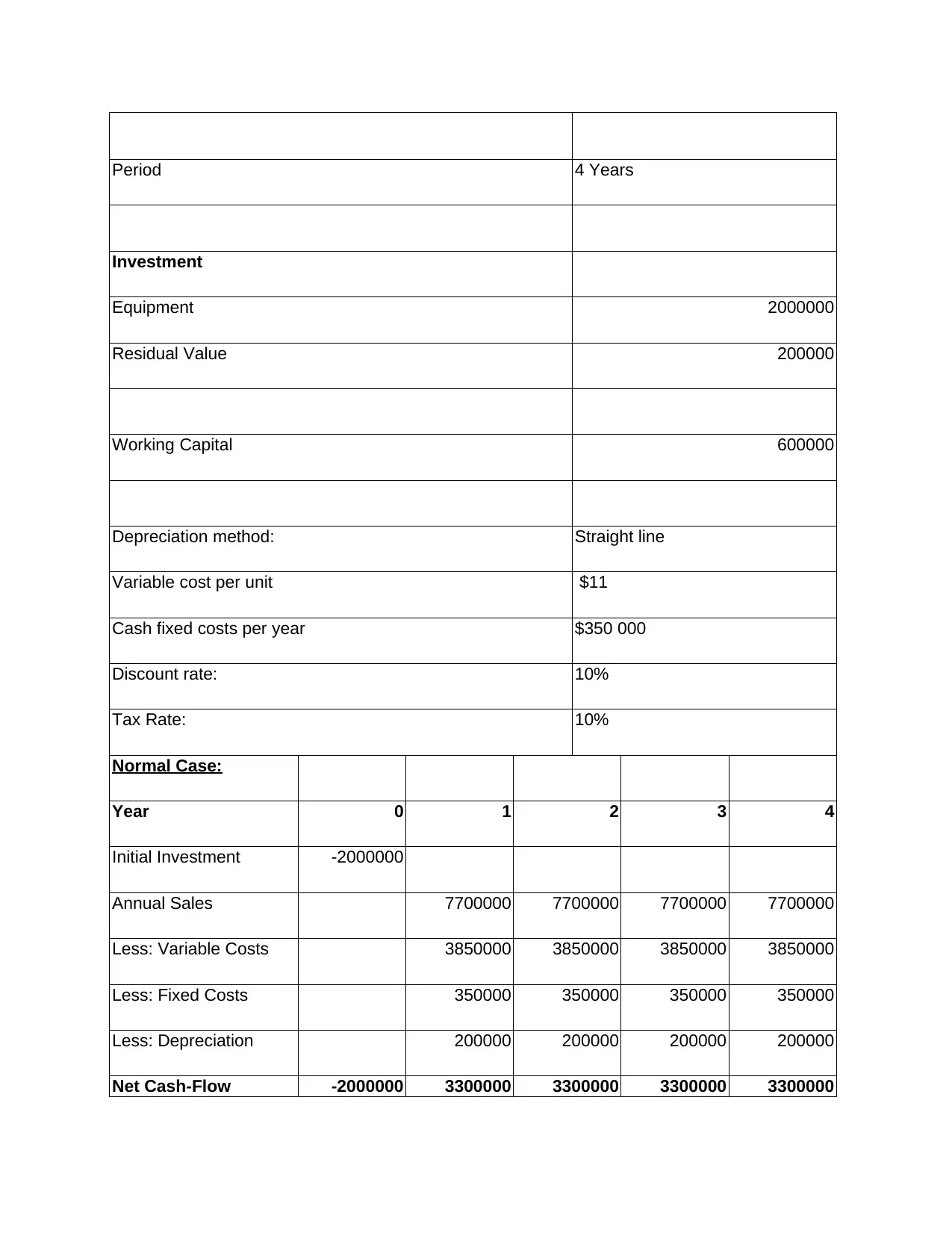
Investment
Equipment 2000000
Residual Value 200000
Working Capital 600000
Depreciation method: Straight line
Variable cost per unit $11
Cash fixed costs per year $350 000
Discount rate: 10%
Tax Rate: 10%
Normal Case:
Year 0 1 2 3 4
Initial Investment -2000000
Annual Sales 7700000 7700000 7700000 7700000
Less: Variable Costs 3850000 3850000 3850000 3850000
Less: Fixed Costs 350000 350000 350000 350000
Less: Depreciation 200000 200000 200000 200000
Net Cash-Flow -2000000 3300000 3300000 3300000 3300000

0.892857142
9
0.446428571
4
0.398596938
8
0.355890123
9
PV of Net Cash-Flow -2000000
3169642.857
14286
1584821.428
57143
1415019.132
65306
1263409.939
8688
NPV
4932893.358
23615
Worst Case:
Selling Price (10%
Decrease) $10
Expected Selling Units
(10% Decrease) 360000
Variable cost per unit
(10% Increase) $12.1
Year 0 1 2 3 4
Initial Investment -2000000
Annual Sales 7200000 7200000 7200000 7200000
Less: Variable Costs 6480000 6480000 6480000 6480000
Less: Fixed Costs 450000 550000 650000 750000
Less: Depreciation 500000 500000 500000 500000
Net Cash-Flow -2500000 -230000 -330000 -430000 -530000
⊘ This is a preview!⊘
Do you want full access?
Subscribe today to unlock all pages.

Trusted by 1+ million students worldwide
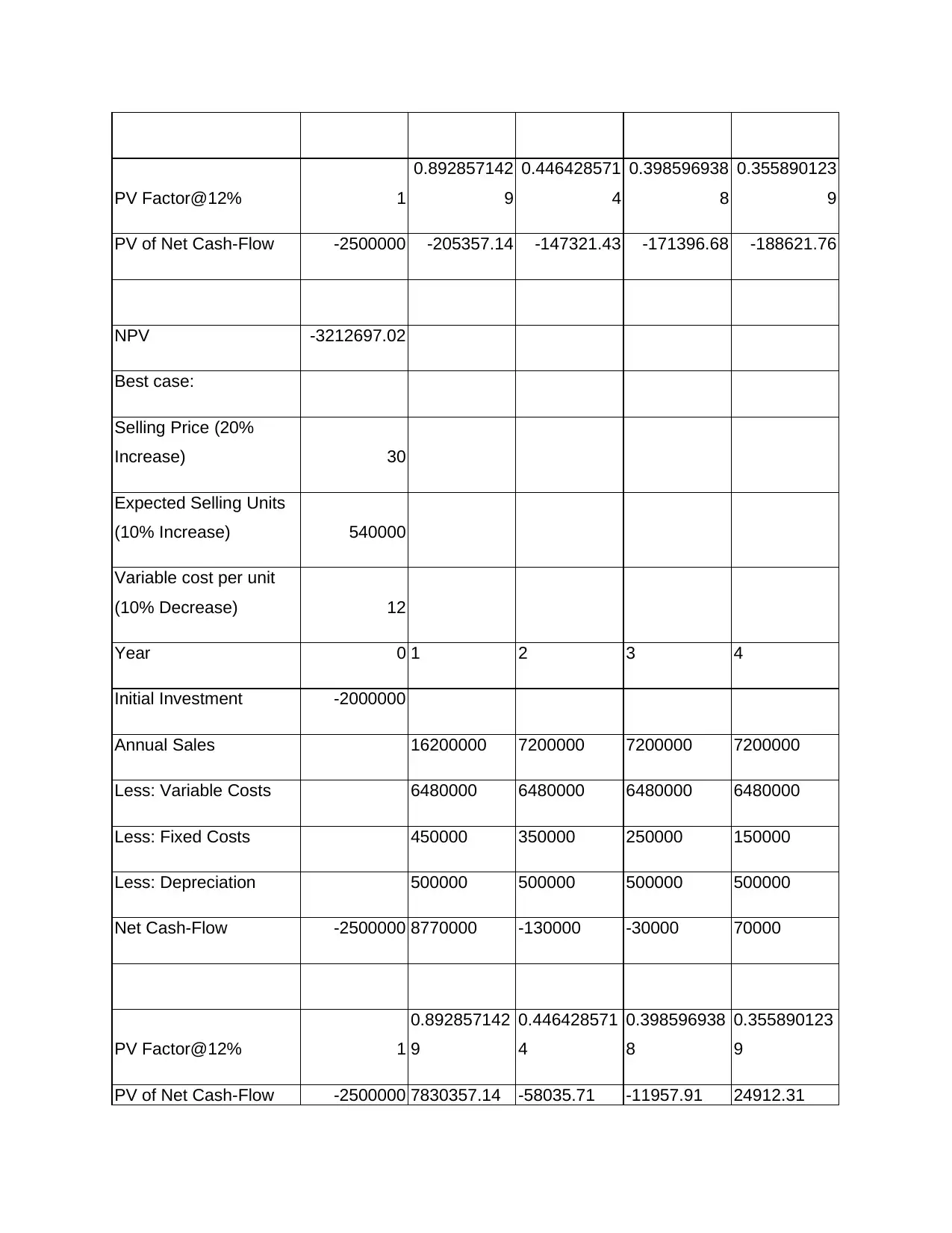
0.892857142
9
0.446428571
4
0.398596938
8
0.355890123
9
PV of Net Cash-Flow -2500000 -205357.14 -147321.43 -171396.68 -188621.76
NPV -3212697.02
Best case:
Selling Price (20%
Increase) 30
Expected Selling Units
(10% Increase) 540000
Variable cost per unit
(10% Decrease) 12
Year 0 1 2 3 4
Initial Investment -2000000
Annual Sales 16200000 7200000 7200000 7200000
Less: Variable Costs 6480000 6480000 6480000 6480000
Less: Fixed Costs 450000 350000 250000 150000
Less: Depreciation 500000 500000 500000 500000
Net Cash-Flow -2500000 8770000 -130000 -30000 70000
PV Factor@12% 1
0.892857142
9
0.446428571
4
0.398596938
8
0.355890123
9
PV of Net Cash-Flow -2500000 7830357.14 -58035.71 -11957.91 24912.31
Paraphrase This Document
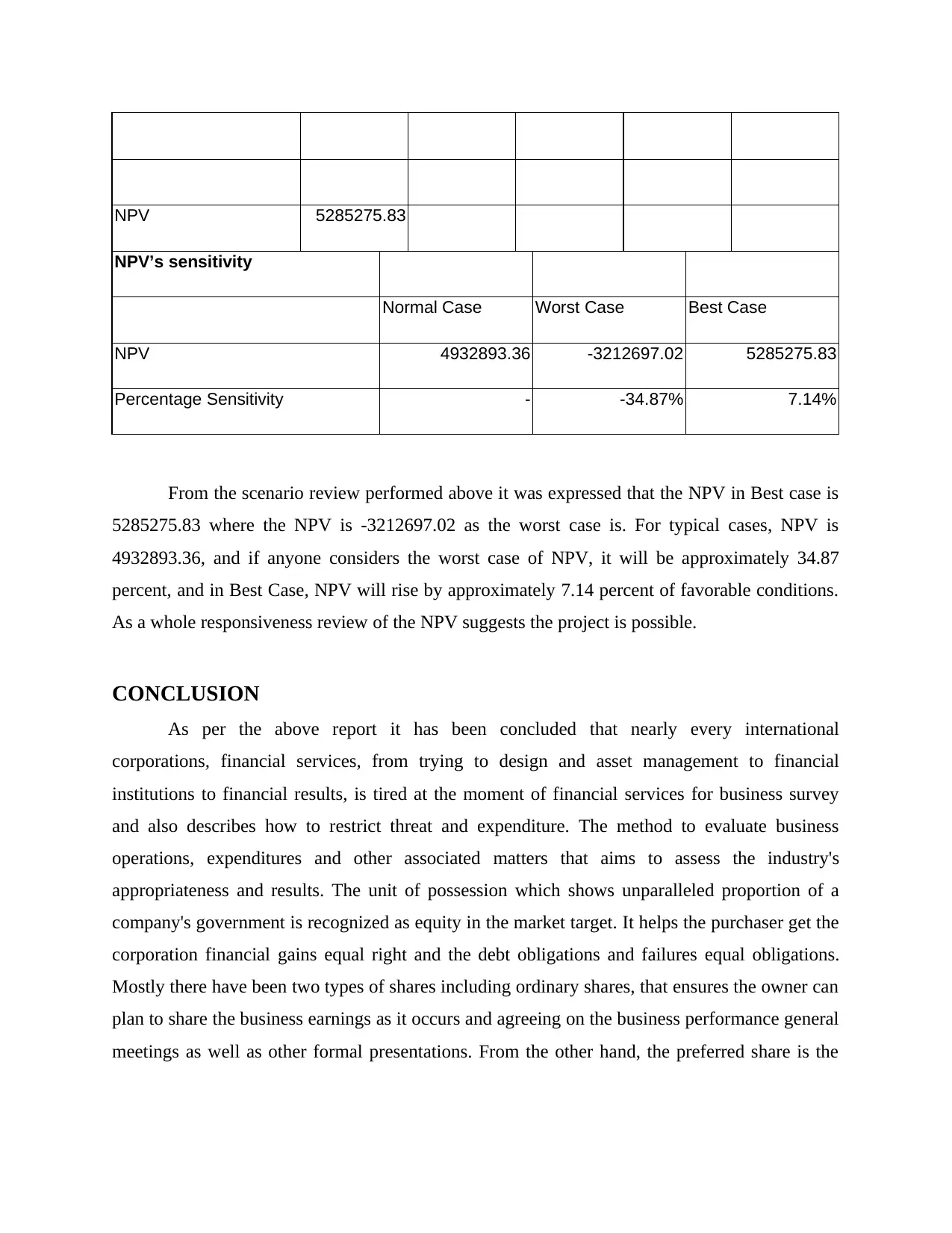
NPV’s sensitivity
Normal Case Worst Case Best Case
NPV 4932893.36 -3212697.02 5285275.83
Percentage Sensitivity - -34.87% 7.14%
From the scenario review performed above it was expressed that the NPV in Best case is
5285275.83 where the NPV is -3212697.02 as the worst case is. For typical cases, NPV is
4932893.36, and if anyone considers the worst case of NPV, it will be approximately 34.87
percent, and in Best Case, NPV will rise by approximately 7.14 percent of favorable conditions.
As a whole responsiveness review of the NPV suggests the project is possible.
CONCLUSION
As per the above report it has been concluded that nearly every international
corporations, financial services, from trying to design and asset management to financial
institutions to financial results, is tired at the moment of financial services for business survey
and also describes how to restrict threat and expenditure. The method to evaluate business
operations, expenditures and other associated matters that aims to assess the industry's
appropriateness and results. The unit of possession which shows unparalleled proportion of a
company's government is recognized as equity in the market target. It helps the purchaser get the
corporation financial gains equal right and the debt obligations and failures equal obligations.
Mostly there have been two types of shares including ordinary shares, that ensures the owner can
plan to share the business earnings as it occurs and agreeing on the business performance general
meetings as well as other formal presentations. From the other hand, the preferred share is the

of the annual assembly they do not have the right.
⊘ This is a preview!⊘
Do you want full access?
Subscribe today to unlock all pages.

Trusted by 1+ million students worldwide
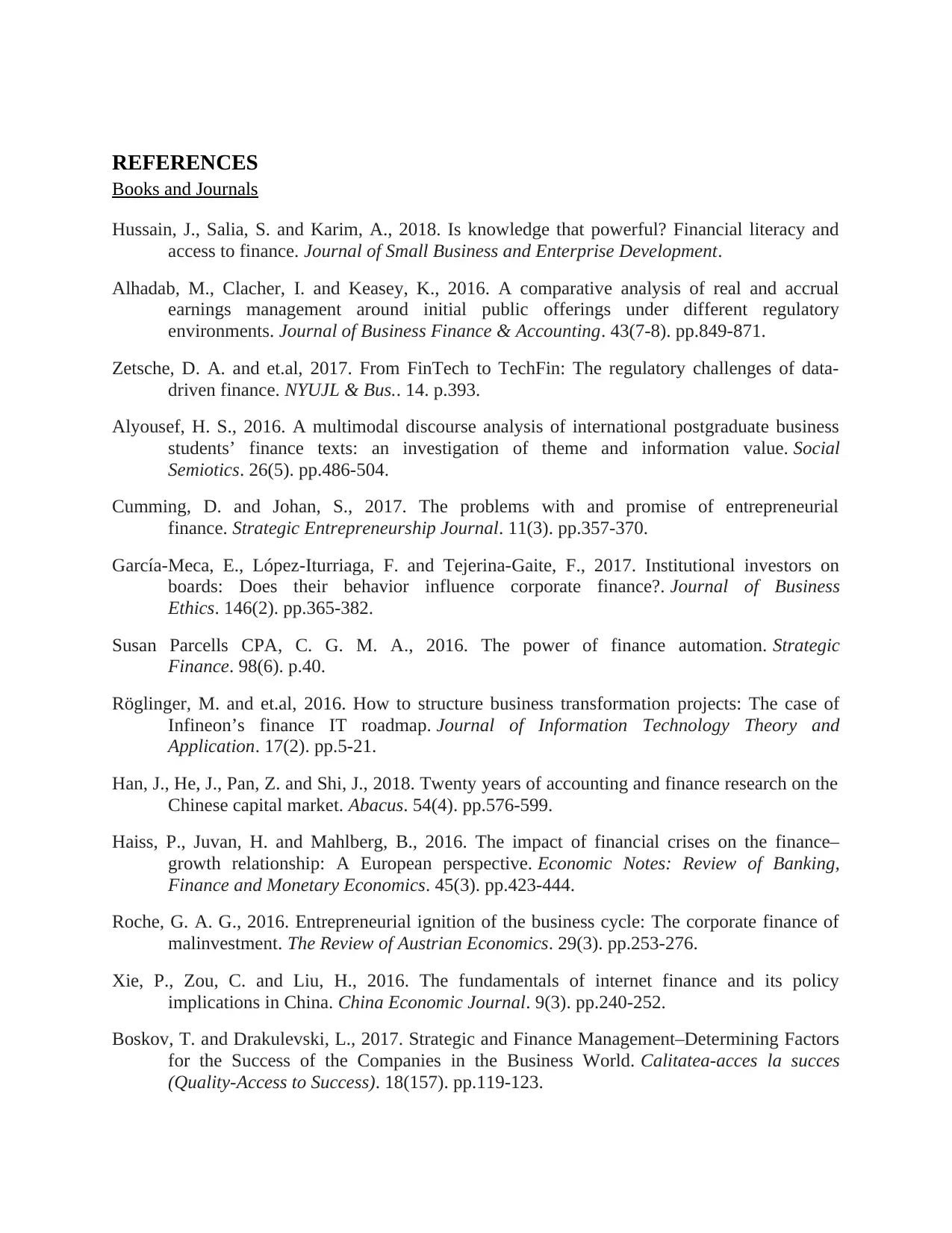
Books and Journals
Hussain, J., Salia, S. and Karim, A., 2018. Is knowledge that powerful? Financial literacy and
access to finance. Journal of Small Business and Enterprise Development.
Alhadab, M., Clacher, I. and Keasey, K., 2016. A comparative analysis of real and accrual
earnings management around initial public offerings under different regulatory
environments. Journal of Business Finance & Accounting. 43(7-8). pp.849-871.
Zetsche, D. A. and et.al, 2017. From FinTech to TechFin: The regulatory challenges of data-
driven finance. NYUJL & Bus.. 14. p.393.
Alyousef, H. S., 2016. A multimodal discourse analysis of international postgraduate business
students’ finance texts: an investigation of theme and information value. Social
Semiotics. 26(5). pp.486-504.
Cumming, D. and Johan, S., 2017. The problems with and promise of entrepreneurial
finance. Strategic Entrepreneurship Journal. 11(3). pp.357-370.
García-Meca, E., López-Iturriaga, F. and Tejerina-Gaite, F., 2017. Institutional investors on
boards: Does their behavior influence corporate finance?. Journal of Business
Ethics. 146(2). pp.365-382.
Susan Parcells CPA, C. G. M. A., 2016. The power of finance automation. Strategic
Finance. 98(6). p.40.
Röglinger, M. and et.al, 2016. How to structure business transformation projects: The case of
Infineon’s finance IT roadmap. Journal of Information Technology Theory and
Application. 17(2). pp.5-21.
Han, J., He, J., Pan, Z. and Shi, J., 2018. Twenty years of accounting and finance research on the
Chinese capital market. Abacus. 54(4). pp.576-599.
Haiss, P., Juvan, H. and Mahlberg, B., 2016. The impact of financial crises on the finance–
growth relationship: A European perspective. Economic Notes: Review of Banking,
Finance and Monetary Economics. 45(3). pp.423-444.
Roche, G. A. G., 2016. Entrepreneurial ignition of the business cycle: The corporate finance of
malinvestment. The Review of Austrian Economics. 29(3). pp.253-276.
Xie, P., Zou, C. and Liu, H., 2016. The fundamentals of internet finance and its policy
implications in China. China Economic Journal. 9(3). pp.240-252.
Boskov, T. and Drakulevski, L., 2017. Strategic and Finance Management–Determining Factors
for the Success of the Companies in the Business World. Calitatea-acces la succes
(Quality-Access to Success). 18(157). pp.119-123.
Paraphrase This Document

Finance. 98(1). p.24.
Ortiz, H. and Muniesa, F., 2018. Business schools, the anxiety of finance, and the order of the
‘middle tier’. Journal of Cultural Economy. 11(1), pp.1-19.
Online
< https://www.asx.com.au/listings/listing-with-asx/is-listing-for-you.htm>
< https://www.asx.com.au/listings/listing-with-asx/listing-fees.htm>
< https://www.asx.com.au/prices/cost-listing.htm>
< https://asic.gov.au/for-finance-professionals/afs-licensees/financial-advisers-register/>
Related Documents
Your All-in-One AI-Powered Toolkit for Academic Success.
+13062052269
info@desklib.com
Available 24*7 on WhatsApp / Email
![[object Object]](/_next/static/media/star-bottom.7253800d.svg)
© 2024 | Zucol Services PVT LTD | All rights reserved.





